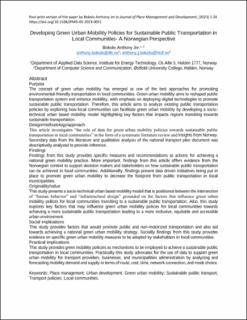| dc.contributor.author | Bokolo, Anthony Junior | |
| dc.date.accessioned | 2024-03-20T14:26:51Z | |
| dc.date.available | 2024-03-20T14:26:51Z | |
| dc.date.created | 2023-12-15T12:45:45Z | |
| dc.date.issued | 2023 | |
| dc.identifier.citation | Journal of Place Management and Development. 2024, 17 (1), 136-155. | en_US |
| dc.identifier.issn | 1753-8335 | |
| dc.identifier.uri | https://hdl.handle.net/11250/3123458 | |
| dc.description.abstract | Purpose
The concept of green urban mobility has emerged as one of the best approaches for promoting environmental-friendly transportation in local communities. Green urban mobility aims to reshape public transportation system and enhance mobility, with emphasis on deploying digital technologies to promote sustainable public transportation. Therefore, this study aims to analyze existing public transportation policies by exploring how local communities can facilitate green urban mobility by developing a sociotechnical urban-based mobility model highlighting key factors that impact regions transitioning toward sustainable transportation.
Design/methodology/approach
This study investigates “the role of data for green urban mobility policies toward sustainable public transportation in local communities” in the form of a systematic literature review and insights from Norway. Secondary data from the literature and qualitative analysis of the national transport plan document was descriptively analyzed to provide inference.
Findings
Findings from this study provides specific measures and recommendations as actions for achieving a national green mobility practice. More important, findings from this study offers evidence from the Norwegian context to support decision-makers and stakeholders on how sustainable public transportation can be achieved in local communities. In addition, findings present data-driven initiatives being put in place to promote green urban mobility to decrease the footprint from public transportation in local municipalities.
Practical implications
This study provides green mobility policies as mechanisms to be used to achieve a sustainable public transportation in local communities. Practically, this study advocates for the use of data to support green urban mobility for transport providers, businesses and municipalities administration by analyzing and forecasting mobility demand and supply in terms of route, cost, time, network connection and mode choice.
Social implications
This study provides factors that would promote public and nonmotorized transportation and also aid toward achieving a national green urban mobility strategy. Socially, findings from this study provides evidence on specific green urban mobility measures to be adopted by stakeholders in local communities.
Originality/value
This study presents a sociotechnical urban-based mobility model that is positioned between the intersection of “human behavior” and “infrastructural design” grounded on the factors that influence green urban mobility policies for local communities transiting to a sustainable public transportation. Also, this study explores key factors that may influence green urban mobility policies for local communities toward achieving a more sustainable public transportation leading to a more inclusive, equitable and accessible urban environment. | en_US |
| dc.language.iso | eng | en_US |
| dc.publisher | Emerald | en_US |
| dc.subject | place management | en_US |
| dc.subject | urban development | en_US |
| dc.subject | green urban mobility | en_US |
| dc.subject | sustainable public transport | en_US |
| dc.subject | transport policies | en_US |
| dc.subject | local communities | en_US |
| dc.title | Developing green urban mobility policies for sustainable public transportation in local communities: a Norwegian perspective | en_US |
| dc.type | Peer reviewed | en_US |
| dc.type | Journal article | en_US |
| dc.description.version | acceptedVersion | en_US |
| dc.rights.holder | © 2023, Emerald Publishing Limited | en_US |
| dc.subject.nsi | VDP::Samfunnsvitenskap: 200::Urbanisme og fysisk planlegging: 230 | en_US |
| dc.subject.nsi | VDP::Teknologi: 500 | en_US |
| dc.source.pagenumber | 136-155 | en_US |
| dc.source.volume | 17 | en_US |
| dc.source.journal | Journal of Place Management and Development | en_US |
| dc.source.issue | 1 | en_US |
| dc.identifier.doi | 10.1108/JPMD-05-2023-0051 | |
| dc.identifier.cristin | 2214134 | |
| cristin.ispublished | true | |
| cristin.fulltext | postprint | |
| cristin.qualitycode | 1 | |
